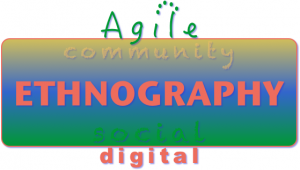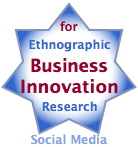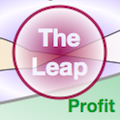 As Marc Andreessen once quipped, software is “eating the world,” embedding itself in all material and digital products. The basis of his remark was that digital interaction was an order of magnitude faster and more efficient than analog. As Marc Andreessen once quipped, software is “eating the world,” embedding itself in all material and digital products. The basis of his remark was that digital interaction was an order of magnitude faster and more efficient than analog.
Design will eat user documentation explains that now a much more profound change is afoot because design is permeating everything that humans make. People are more likely to use things that have been explicitly designed for them because products’ ease of use and relevance are greater.
[…]
 Agile Digital Ethnography uses an ethnographic research approach to analyze people’s online interactions. It creates a dynamic new market research capability that’s useful by itself and even more when used with surveys, focus groups, field work, and other primary research. Agile Digital Ethnography uses an ethnographic research approach to analyze people’s online interactions. It creates a dynamic new market research capability that’s useful by itself and even more when used with surveys, focus groups, field work, and other primary research.
I have learned that Agile Digital Ethnography provides a unique combination of research results. I have used it on client engagements since 2006. Like primary research, it reveals people’s behavior, thoughts, emotions, and motivations in rich detail; however, because it’s secondary research, it’s faster and less costly than most other methods. It’s very useful when it’s conducted before primary research since its results can inform the design of primary research instruments.
[…]
How to Boost the Power of Customer Journey Maps shows how firms can increase the accuracy and power of their journey maps by using digital social data in practical new ways that almost all customer experience pros overlook. […]
 Why T-Mobile Needs a Chief Customer Officer shows how customers’ omni-channel interactions with enterprises demand profound integration of business processes, and how firms’ failure to “go all the way” in breaking down silos ultimately threatens business. Most firms don’t go far enough, including T-Mobile, and their silo-centric efforts fail to get the job done. To illustrate the point, I’ll share how T-Mobile alienates fans like me by not delivering what they promise. Why T-Mobile Needs a Chief Customer Officer shows how customers’ omni-channel interactions with enterprises demand profound integration of business processes, and how firms’ failure to “go all the way” in breaking down silos ultimately threatens business. Most firms don’t go far enough, including T-Mobile, and their silo-centric efforts fail to get the job done. To illustrate the point, I’ll share how T-Mobile alienates fans like me by not delivering what they promise.
This story also shows that the need for a CCO is particularly acute in mature economies like the U.S.A. and Europe because their silos were built decades ago, and their legacy processes often adversely affect customer experience.
[…]
 Customer experience and experiential social media shows how you can succeed in transforming your customers’ experiences with your firm by adopting a refreshing and effective human approach. Transforming customer experience enables most firms to become more resilient and profitable. Customer experience and experiential social media shows how you can succeed in transforming your customers’ experiences with your firm by adopting a refreshing and effective human approach. Transforming customer experience enables most firms to become more resilient and profitable.
If you’d like to watch this post instead of reading it, click the thumbnail button.
[…]
 Ethnographic research for design explains how to use advances in ethnographic research of social media to design products, services, experiences… anything—while getting better results at lower risk. Ethnographic research of social media is breakthrough for designers in the “design stack” in which I’ve includedArchitecture/Interior Design, Product Design, User Experience Design/Interaction Design, UX Strategy, Service Design and Customer Experience Design. Ethnographic research for design explains how to use advances in ethnographic research of social media to design products, services, experiences… anything—while getting better results at lower risk. Ethnographic research of social media is breakthrough for designers in the “design stack” in which I’ve includedArchitecture/Interior Design, Product Design, User Experience Design/Interaction Design, UX Strategy, Service Design and Customer Experience Design.
Designers in all fields lament clients’ resistance to funding robust research. Traditional design research methods are often grounded in asking proposed users explicit questions, and self-reported responses vary significantly from actual behavior despite respondents’ best intentions. Similarly, shadowing, service safaris, “a day in the life,” and other analog research methods are costly and slow. Sample sizes are necessarily small because scaling analog methods greatly multiplies the budget and length of the research phase. Ethnographic research of social media changes the game because it studies proposed users’ actual behavior in digital public when they’re having heated discussions about the outcomes they want when the proposed product, service, or process is useful to them. It […]
 Ethnographic research for business innovation shows how to apply ethnographic research of social media to managing controlled disruption within organizations. Ethnographic research of social media can transform the entire innovation process because it’s a very efficient way to study the behavior and motivations of the people that the innovation proposes to serve. Unlike traditional innovation and ethnographic research methods, which are relatively slow, costly and qualitative, ethnographic research of social media combines qualitative richness with quantitative analysis. It’s faster and less costly, too. Ethnographic research for business innovation shows how to apply ethnographic research of social media to managing controlled disruption within organizations. Ethnographic research of social media can transform the entire innovation process because it’s a very efficient way to study the behavior and motivations of the people that the innovation proposes to serve. Unlike traditional innovation and ethnographic research methods, which are relatively slow, costly and qualitative, ethnographic research of social media combines qualitative richness with quantitative analysis. It’s faster and less costly, too.
Ethnographic research for business innovation can dramatically improve the depth and breadth of business and corporate strategy, business design and service design research since it allows teams to consider more users and to assess their behavior and motivations, which can improve the value of more costly research.
This post outlines the business innovation use case of ethnographic research of social media, and it includes examples in banking, professional services, consumer products, and B2B marketing. For more on ethnographic research, see More Resources below.
[…]
 Ethnographic research for product management shows how to apply ethnographic research of social media to managing the life cycle of products and services. Ethnographic research of social media can revolutionize product management because it’s a very efficient way to study people’s behavior and motivations in each part of the product life cycle. Unlike traditional product and ethnographic research methods, which are relatively slow, costly and qualitative, ethnographic research of social media combines qualitative richness with quantitative analysis. It’s faster and less costly, too. Ethnographic research for product management shows how to apply ethnographic research of social media to managing the life cycle of products and services. Ethnographic research of social media can revolutionize product management because it’s a very efficient way to study people’s behavior and motivations in each part of the product life cycle. Unlike traditional product and ethnographic research methods, which are relatively slow, costly and qualitative, ethnographic research of social media combines qualitative richness with quantitative analysis. It’s faster and less costly, too.
This post outlines the product management use case of ethnographic research of social media. For more on ethnographic research, see its executive summary.
[…]
 Autonomy Artificial Intelligence and the Internet of Things reflects on how people’s autonomy will be affected by software-powered devices and systems that are rapidly permeating our individual and social lives. Autonomy Artificial Intelligence and the Internet of Things reflects on how people’s autonomy will be affected by software-powered devices and systems that are rapidly permeating our individual and social lives.
Although this noodle has a strong personal angle for me, I also have the unusual benefit of having regular conversations with people who are leading the redesign of our “environment.” By superimposing digital devices, sensors, and “intelligence” onto the physical world, designers, engineers, policy makers, behavioral economists, neuroscientists, nanoscientists, and investors, just to name a few, are changing how we perceive and interact with our “world,” so I’ll also bring my insights from those conversations to it. Finally, I’ll consider creator and user points of view on autonomy artificial intelligence and the Internet of things.
[…]
 How Trusting Customers Drives Profit reveals how firms unwittingly broadcast that they don’t trust their customers, how that weakens profit, and how firms can take the leap. It’s a simple revolutionary idea that’s born from nine years of studying behavior while practicing experiential social media and social business. How Trusting Customers Drives Profit reveals how firms unwittingly broadcast that they don’t trust their customers, how that weakens profit, and how firms can take the leap. It’s a simple revolutionary idea that’s born from nine years of studying behavior while practicing experiential social media and social business.
Analysts, consultants and professors increasingly say that customer experience is the last bastion of competitiveness, and an increasing portion of total experience occurs in digital public. This presents firms with an unprecedented opportunity: interacting with people in digital public can create trust at scale and drive profit from revenue and cost levers.
[…]
|
|
 As Marc Andreessen once quipped, software is “eating the world,” embedding itself in all material and digital products. The basis of his remark was that digital interaction was an order of magnitude faster and more efficient than analog.
As Marc Andreessen once quipped, software is “eating the world,” embedding itself in all material and digital products. The basis of his remark was that digital interaction was an order of magnitude faster and more efficient than analog.
 Agile Digital Ethnography uses an ethnographic research approach to analyze people’s online interactions. It creates a dynamic new market research capability that’s useful by itself and even more when used with surveys, focus groups, field work, and other primary research.
Agile Digital Ethnography uses an ethnographic research approach to analyze people’s online interactions. It creates a dynamic new market research capability that’s useful by itself and even more when used with surveys, focus groups, field work, and other primary research. Why T-Mobile Needs a Chief Customer Officer shows how customers’ omni-channel interactions with enterprises demand profound integration of business processes, and how firms’ failure to “go all the way” in breaking down silos ultimately threatens business. Most firms don’t go far enough, including T-Mobile, and their silo-centric efforts fail to get the job done. To illustrate the point, I’ll share how T-Mobile alienates fans like me by not delivering what they promise.
Why T-Mobile Needs a Chief Customer Officer shows how customers’ omni-channel interactions with enterprises demand profound integration of business processes, and how firms’ failure to “go all the way” in breaking down silos ultimately threatens business. Most firms don’t go far enough, including T-Mobile, and their silo-centric efforts fail to get the job done. To illustrate the point, I’ll share how T-Mobile alienates fans like me by not delivering what they promise. Customer experience and experiential social media shows how you can succeed in transforming your customers’ experiences with your firm by adopting a refreshing and effective human approach. Transforming customer experience enables most firms to become more resilient and profitable.
Customer experience and experiential social media shows how you can succeed in transforming your customers’ experiences with your firm by adopting a refreshing and effective human approach. Transforming customer experience enables most firms to become more resilient and profitable. Ethnographic research for design explains how to use advances in ethnographic research of social media to design products, services, experiences… anything—while getting better results at lower risk. Ethnographic research of social media is breakthrough for designers in the “design stack” in which I’ve includedArchitecture/Interior Design, Product Design, User Experience Design/Interaction Design, UX Strategy, Service Design and Customer Experience Design.
Ethnographic research for design explains how to use advances in ethnographic research of social media to design products, services, experiences… anything—while getting better results at lower risk. Ethnographic research of social media is breakthrough for designers in the “design stack” in which I’ve includedArchitecture/Interior Design, Product Design, User Experience Design/Interaction Design, UX Strategy, Service Design and Customer Experience Design. Ethnographic research for business innovation shows how to apply ethnographic research of social media to managing controlled disruption within organizations. Ethnographic research of social media can transform the entire innovation process because it’s a very efficient way to study the behavior and motivations of the people that the innovation proposes to serve. Unlike traditional innovation and ethnographic research methods, which are relatively slow, costly and qualitative, ethnographic research of social media combines qualitative richness with quantitative analysis. It’s faster and less costly, too.
Ethnographic research for business innovation shows how to apply ethnographic research of social media to managing controlled disruption within organizations. Ethnographic research of social media can transform the entire innovation process because it’s a very efficient way to study the behavior and motivations of the people that the innovation proposes to serve. Unlike traditional innovation and ethnographic research methods, which are relatively slow, costly and qualitative, ethnographic research of social media combines qualitative richness with quantitative analysis. It’s faster and less costly, too. Ethnographic research for product management shows how to apply ethnographic research of social media to managing the life cycle of products and services. Ethnographic research of social media can revolutionize product management because it’s a very efficient way to study people’s behavior and motivations in each part of the product life cycle. Unlike traditional product and ethnographic research methods, which are relatively slow, costly and qualitative, ethnographic research of social media combines qualitative richness with quantitative analysis. It’s faster and less costly, too.
Ethnographic research for product management shows how to apply ethnographic research of social media to managing the life cycle of products and services. Ethnographic research of social media can revolutionize product management because it’s a very efficient way to study people’s behavior and motivations in each part of the product life cycle. Unlike traditional product and ethnographic research methods, which are relatively slow, costly and qualitative, ethnographic research of social media combines qualitative richness with quantitative analysis. It’s faster and less costly, too. Autonomy Artificial Intelligence and the Internet of Things reflects on how people’s autonomy will be affected by software-powered devices and systems that are rapidly permeating our individual and social lives.
Autonomy Artificial Intelligence and the Internet of Things reflects on how people’s autonomy will be affected by software-powered devices and systems that are rapidly permeating our individual and social lives.